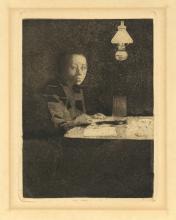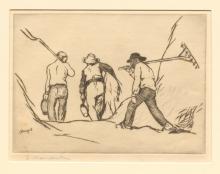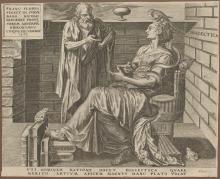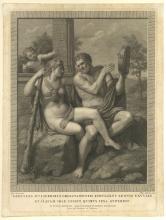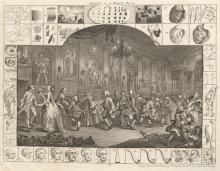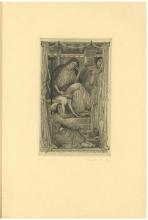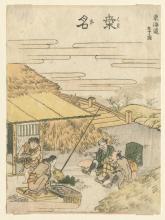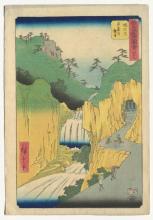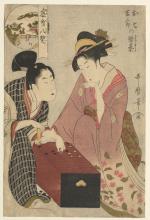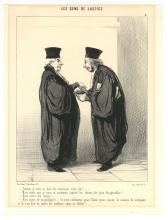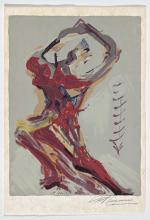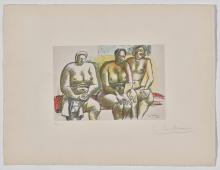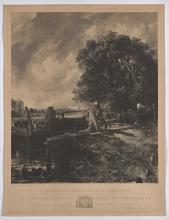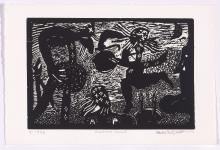The definitions below are excerpted from Paul Goldman, Looking at Prints, Drawings and Watercolours. A Guide to Technical Terms (London: The British Museum Press and Los Angeles: Getty Publications, 2006) unless otherwise stated.
Aquatint: A variety of etching and essentially a tone process which can be used to imitate the appearance of watercolor washes. The chief element of the process, which was invented in France in the 1760s, is the partial protection of the surface of the plate with a porous ground through which the acid can penetrate. The plate is covered with a ground of powdered resin which is attached to the plate by heating. … The printmaker will ‘stop out’ with a protecting varnish any parts of the ground where he wishes to obtain pure white. …
Drypoint: A member of the class of intaglio prints. The line is scratched directly into the plate with a metal point, which is pulled across the surface and not pushed as in engraving. The metal displaced from the scratched line is thrown up on either side, and this residue of metal fragments is called the ‘burr’. This gives the line a rich velvety texture when inked, but the burr is fragile and quickly wears down with each impression. … Drypoint is often used in combination with other techniques, especially etching. …
Engraving: A term sometimes used of all intaglio prints but properly confined to those made with a tool called a ‘graver’ or ‘burin’, which is a small metal rod with a sharpened point. It is pushed across the plate, forcing the metal up into slivers in front of the V-shaped line. These pieces of metal are removed from the plate with a sharp bladed instrument (the ‘scraper’.) An engraving can usually be distinguished from an etching by the ends of the lines: these taper into a point in engraving, but in an etching the ends are blunt and rounded. An engraved line, being cut, is sharp and clean, whereas an etched line, being drawn and bitten unevenly by the acid, is slightly irregular.
Etching: A variety of intaglio printmaking in which the lines in a metal plate are bitten (etched = eaten) by acid. The polished surface of the plate is first covered with a thin layer of ground, composed of waxes, gums and resins. The melted ground is usually laid on with a ‘roller’ or ‘dabber’. The etcher draws through the ground with a metal point (the ‘etching needle’), which exposes the metal. The plate is then immersed in a bath of acid, which bites into the plate through the exposed lines. The depth of the line, and thus its darkness when printed, is determined by the length of time the plate remains in the bath and the strength of the acid solution. The etching ground offers almost no resistance to the needle, so the artist has much the same freedom as in drawing. …
Intaglio Printing: The method of printing used for metal plates worked as engravings, drypoints, etchings, stipples and aquatints. The paper receives the ink from the incised lines and not from the surface of the plate. The ink is pressed into the lines with a pad called a ‘dabber’. Any left on the surface is removed by wiping muslin across the plate, and the process is usually completed by hand. The paper is dampened and passed through a press … . The pressure must be strong enough to force the damp paper into the lines and lift the ink out onto the paper. …
Japanese Woodblock/Ukiyo-e: The team involved in the production of ukiyo-e was known as the 'ukiyo-e quartet'. It comprised the publisher (who usually had control over the process), the designer/artist, the block cutter and the printer. The artist would draw the design on paper. Once complete, an exact copy was made and placed face-down on a cherry wood block. … The block cutter then carved directly through the copy to produce what is known as the ‘key-block’. The printer used the key-block to produce a number of black and white prints, from which further blocks could be made for each colour needed in the final print. …
Source: https://www.vam.ac.uk/articles/japanese-woodblock-prints-ukiyo-e
Lithography: The basis of lithography is the fact that grease and water repel each other. Anything drawn on a suitable surface in some greasy medium can be printed in the following way: the surface is first dampened with water, which only settles on the unmarked areas since it is repelled by the greasy drawing medium. The surface is then rolled over with a greasy printing ink, which will only adhere to the drawn marks, the water repelling it from the rest of the surface. Finally, the ink is transferred to a sheet of paper by running the paper and the printing surface together through a ‘scraper press’. … Lithographs can present a wide variety of appearance because any kind of drawing instrument can be used so long as the drawing medium itself is greasy.
Mezzotint: A member of the class of intaglio prints, and essentially a tone process in which a metal plate is roughened or ground all over using a tool with a curved and serrated edge (the ‘rocker’), producing an overall ‘burr’ which prints a deep velvety black. The artist scrapes down the burr in proportion to the lightness of tone that he requires. The main distinguishing feature of the process is that the artist works from dark to light.
Relief Printing: The method of printing used for woodcut, wood-engraving and metalcut.
Woodcut: Historically the most important of the relief printing processes. The design is drawn directly on the surface of the wood block which is cut parallel to the grain… . The parts which are to print white are cut away, leaving the black lines in relief. The tool used is usually a knife. The block is then printed on the relief press.

